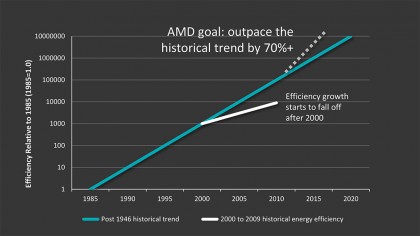
What is AMD Carizzo?
While it's pretty easy to explain Broadwell as a new processor with smaller transistors, AMD's new Carrizo chips are slightly more complicated. To make its more efficient parts, AMD opted to stick with 28nm transistors and arranged them into a more tightly wound bundle made of eight layers.
AMD Corporate Fellow Sam Naffziger explained why tightening up is a good thing, revealing the chip maker's engineers managed to pack in 29% more transistors on Carrizo.
"There is some benefit from shrinking everything because distances [between transistors] are shorter, there's less metal for power to travel across and the gates are smaller," he said.
This means there's less voltage being lost in translation between the processor's transistors. A few tiny charges of electricity might not sound like a lot, but they add up and Carrizo should let laptops squeeze out a bit more battery life than AMD's current A-series of APU processors.
The heat issue
However, Naffziger also noted that, "by packing things more closely, you increase the power density.
"You're just jamming more circuity into the same area and if it's generating the same level of activity, it could get hotter even if it's just burning the same amount of power," he cautioned.
To design around the issue, Naffziger said the team at AMD took care to space the CPU cores accordingly. Every core was moved away from one another and the edges of the processor die to prevent the component from getting any hotter than its A-series predecessor.
Are you a pro? Subscribe to our newsletter
Sign up to the TechRadar Pro newsletter to get all the top news, opinion, features and guidance your business needs to succeed!
Of course, we won't know how successful AMD was at reducing heat until we test Carrizo in a laptop. As we've seen with thin gaming laptops such as the Aorus X7 Pro, even a well-engineered cooling system can't keep up with rip-roaring parts, so there's still the potential Carrizo could be a seriously hot potato when it starts arriving in notebooks.

Mind the droop
As for power savings, AMD expects Carrizo to consume 40% less power than its A-series APUs. Naffziger explained AMD's latest CPU technology utilizes multiple approaches to reduce power needs.
Aside from the inherently decreased power needs of a smaller microarchitecture, the AMD team gated clock processor speed aggressively to prevent the CPU cores from running unnecessarily fast and chewing through battery life.
More importantly, Carrizo focuses on saving power that goes to the CPU and GPU through voltage optimization. Carrizo also drops the processor frequency rate when voltage flowing to the chip's CPU and GPU falls out of spec, otherwise known as a "droop." Typically when processors experience a droop, they have to compensate for the loss of power by introducing more voltage and wasting energy.
Naffziger said the company isn't ready to give exact estimates but power-saving optimizations should amount to improved battery life stretching into double-digit minutes that border on triple digits. This is thanks to aggressive optimizations that turn everything off on the processor diode, which should help reduce power draw when your notebook is on idle or you're using low-resource applications like Microsoft Word.
What's more, Carrizo will be one of the first processors to feature hardware decode to better handle streaming video and save multiple watts of power in the CPU. For gaming, Carrizo will support Mantle and DirectX 12.
When and in what devices will it get here?
Intel hasn't been shy about its plans to fully launch Broadwell on all future notebooks and mobile devices. At CES 2015, the chip maker announced it would release Broadwell parts across its entire CPU line-up, from low-voltage Core M and Celeron processors all the way to gaming machine-grade Core i7 chips. Many of these laptops are on their way to full commercial releases.
Similarly, AMD plans to push Carrizo out in a wide release, though it has yet to announce a release window. However, when it does arrive it will fill out the 12- to 35-watt notebook space. This includes everything from budget laptops to systems with comparable performance to an Intel Core i5 chip.
Sadly, even the lowest wattage processors won't even scratch the 5-watt range of Intel's Core M-powered laptops, so don't expect to see any fanless configurations with Carrizo until AMD announces a processor that's even more lightweight.
Intel's new, smaller Broadwell architecture has already spawned a new series of smaller and lighter laptops, including the Dell XPS 13. We have every expectation AMD's new Carrizo processors will do the same as all signs point to more compact and longer-lasting laptops.
- These are the best Ultrabooks you can get today
Kevin Lee was a former computing reporter at TechRadar. Kevin is now the SEO Updates Editor at IGN based in New York. He handles all of the best of tech buying guides while also dipping his hand in the entertainment and games evergreen content. Kevin has over eight years of experience in the tech and games publications with previous bylines at Polygon, PC World, and more. Outside of work, Kevin is major movie buff of cult and bad films. He also regularly plays flight & space sim and racing games. IRL he's a fan of archery, axe throwing, and board games.
